We arrive in Dinkelsbühl just as the sun comes out after very heavy rain following our visit to Augsburg and are absolutely delighted at our choice of a place to stay for 4 nights. Everywhere we look inside this walled city is a delight – except the parking! We find the Romantica Hotel Blauer Hecht (Blue Pike, hardly very romantic) and Jean Michel double parks outside while I get the key. We unload the car and park just outside the town gates, where there are several free car parks, only ten minutes away. We cycle back on our bikes and leave them in the hotel’s bike room.

Jean Michel is initially not very happy with our room on the second floor, which he says is too dark, but we can’t change it without paying the first night. This is very unlike him – I am usually the one who complains about hotel rooms. However, it’s spacious and has a table and chairs, armchair and sofa. It also has an excellent breakfast, the beds are comfortable and the floors don’t crack too much.

We are drawn into the street by activity and music outside our window. We learn that it is a practice run for the 10-day Children’s Festival starting on Friday, the day we are leaving. During the 30 Years War (1618 – 1648), many areas of Germany were destroyed, while the medieval city of Dinkelsbühl was spared because the children of Dinkelsbühl petitioned the Swedish colonel to grant them freedom. For the past 100 years or so Dinkelsbühl has celebrated the event with a festival during which the entire story is re-enacted.
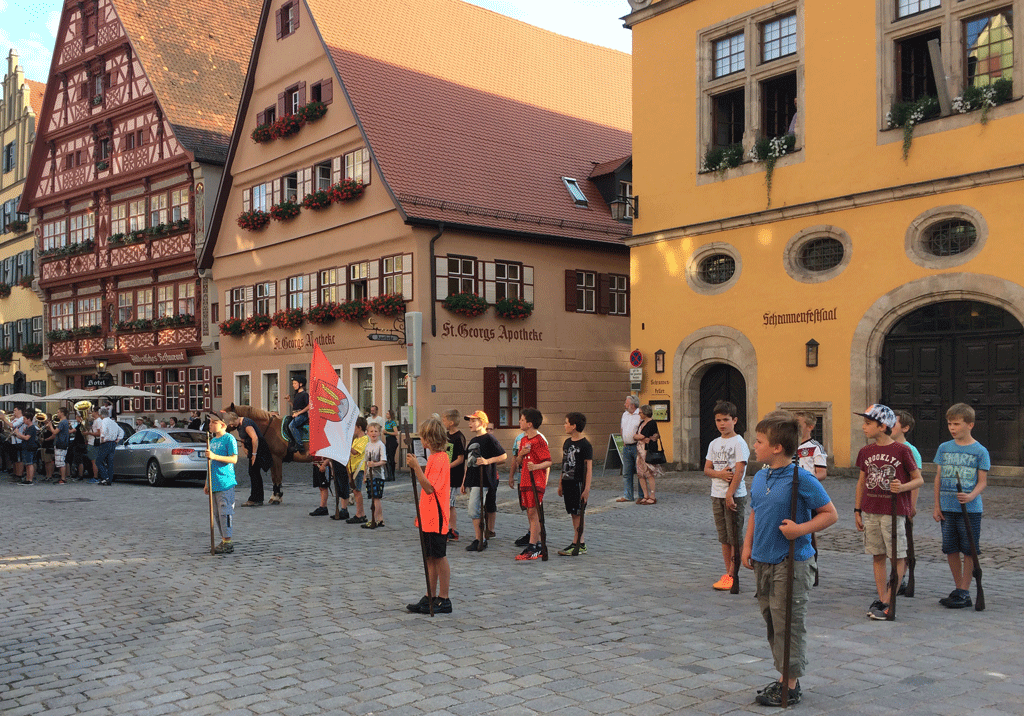
While we are having a drink in the main square, we see another rehearsal with a child of about 8 or 9 on a horse obviously reciting a poem and calling out instructions to the other children around him. It must be quite spectacular when they are in costume but we are not sorry to be leaving before the festivities. I can imagine the crowds!

Next day is a true R&R day with no cycling at all. Jean Michel catches up with our travel journal and me with my blog. We have lunch with the locals – or so Jean Michel is convinced – at Zur Sonne in the Weinmarkt, tasting some local Franconian dishes – sausages and ravioli. Somehow, the rest of the day slips away. In the evening, we hear more practicing which we watch from our window.

The following morning we check the weather report which does not look very promising. After temperatures of 30°C in Peiting, we won’t even top 20°C for the next few days. Rain is also predicted. We decide to cycle while we can and set out for the little town of Feuchtwangen after first riding around the ramparts of Dinkelsbühl.
There are a total of 16 towers and we photograph them all. It really is the most delightful little town. I can fully understand why they keep up the children’s pageant every year. It would be very hard not to be attached to the history of this little gem of a town.

From Dinkelsbühl to Schopfloch, after going past what we assume were once fish farms, we constantly follow a deviation that takes us up hill and down dale with alarming frequency.

We climb another hill up to Lehengütingen and I am getting desperate for a cappuccino. We only see a Greek restaurant. In Germany, these are second only to Italian restaurants in number. It doesn’t say “café” so I ask inside if a cappuccino is possible. A man talking on a cell phone nods, takes my order, makes the cappuccinos which are really excellent, brings them out with one hand and then gets the sugar, without stopping his conversation!
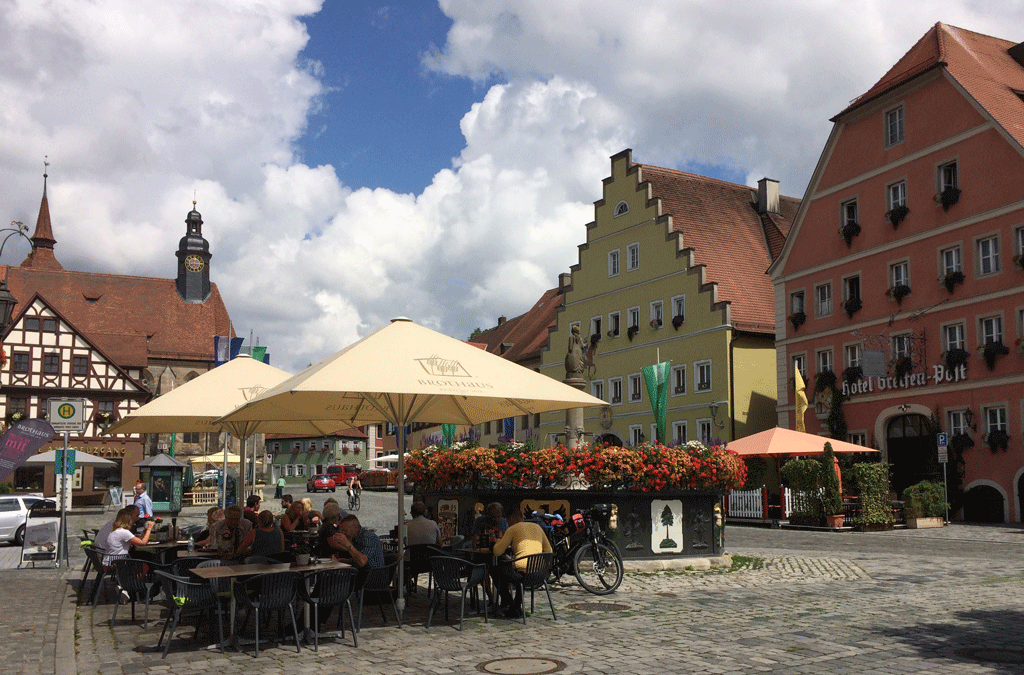
Feuchtwangen proves to be a little town with a pleasant square and a bike shop where I at last manage to buy a decent bike stand.

We visit the other sights, which mainly consist of a very sober evangelical church and a cloister that has been converted into a children’s theatre from what we can see.

Our choice of lunch spot goes to Gasthaus sur Sonne (which roughly means sunny guesthouse) as the sky is getting increasingly overcast. We order schweineschnitzel as a pork variant of wiener schnitzel and are surprised by the quantity. I should have ordered the kleine version.

The ride home takes us through rain, wind and sun. I put on my rain cape once but Jean Michel resists. By the time we get back, after cycling 32 kilometers and for 2 ½ hours, we are dry again thanks to our super-fast-drying sports clothes.

It is a depressing 10°C when we leave the hotel next day which excludes cycling. We are going to Nordlingen, which is 30 kilometers to the south, by car. We’re even wearing jeans, trainers and sweat shirts for the first time since we left Blois two weeks ago.

When we get to Nordlingen, we know why we prefer to cycle into tourist towns. Traffic and parking are always a problem especially when there are ramparts. We soon leave the centre and find free parking outside the walls. Nordlingen is located in the middle of a meteorite crater and is completely surrounded by ramparts that you can walk right around.

We walk into the centre to the tourist office as usual, but I am cold so we warm up with some coffee in an Italian restaurant first. After that, we follow the very well signposted visit of the city which includes the Rathaus, the tanners’ district, several towers and various granaries. I find it much more interesting than Augsburg.
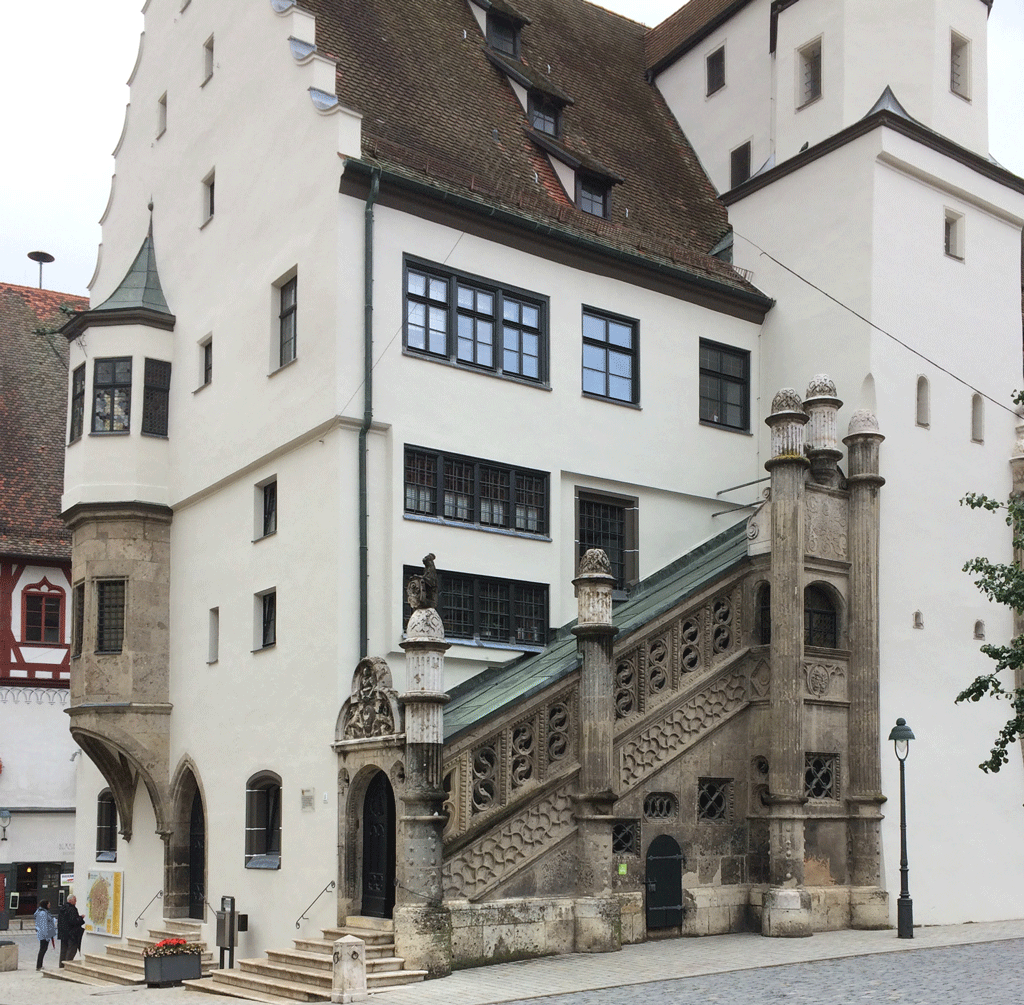

On the way home, we stop off at Wallerstein with its Plague Monument just as the sun comes out. As there is nothing else to see, we leave almost immediately.
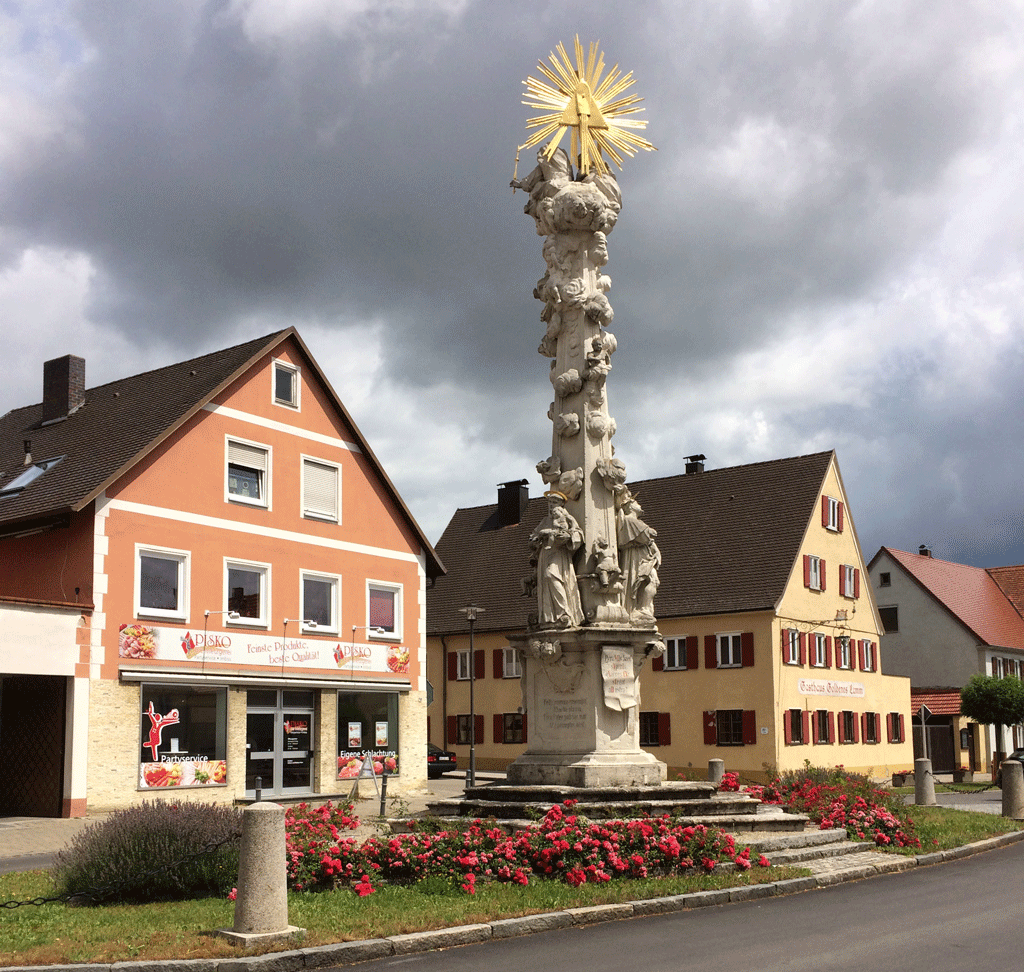
One of my most faithful blog readers, Barbara, has mentioned the cemetery in Segringen just outside Dinkelsbühl. We follow a sign that says Historischer Friedhof so I quickly consult my iPhone dictionary. Yes, Friedhof means cemetery. What we see in the Segringen Evangelical Lutheran cemetery is strange to us. All the tombs are exactly the same, with black and gold crosses. The person’s name, date of birth and death, profession and residence are inscribed on one side and what appears to be a religious quotation on the other. None of the tombs seem to be earlier than 1996.

I later learn, thanks to Google translate because no explanations are available in either French or English, that the cemetery probably dates back to the early 1900s or perhaps mid-19th century. There are no family tombs and people are buried in sequential order; the current resting period is 20 years, which explains why the graves are all so recent.
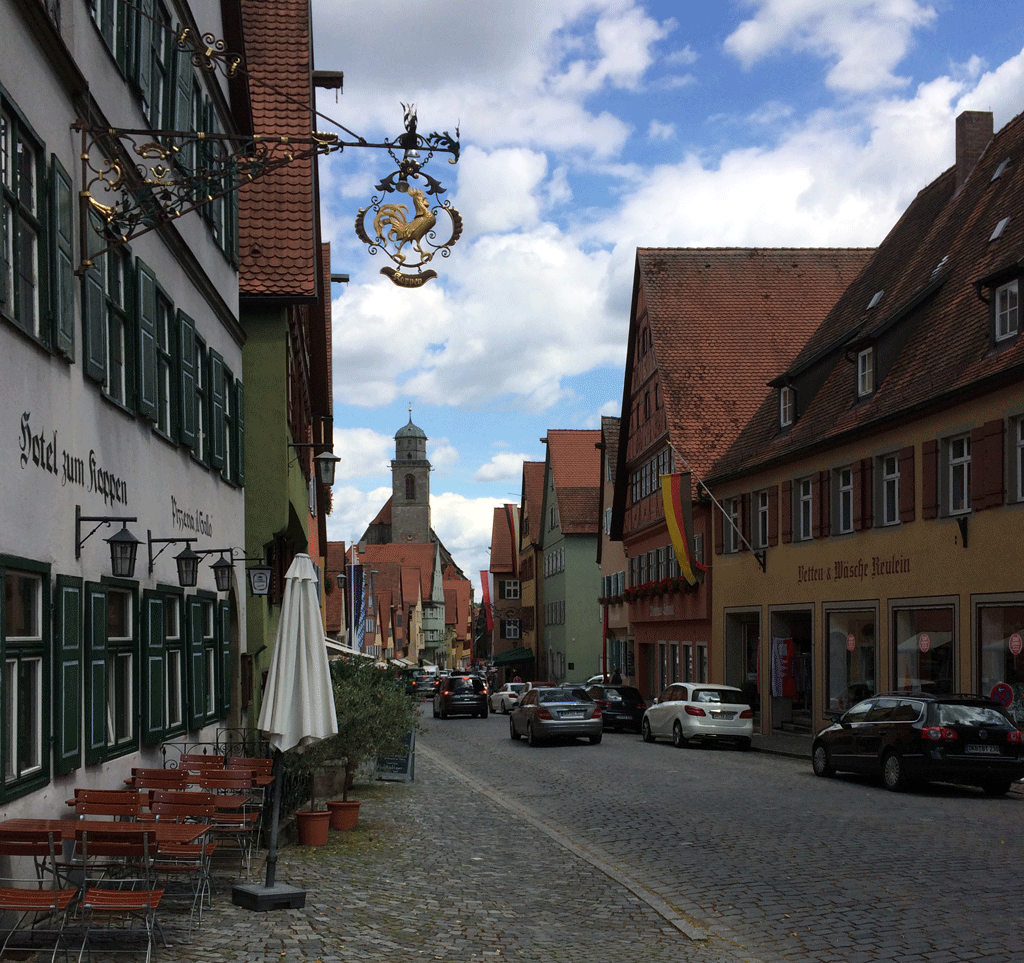
When we get back to Dinkelsbühl, the sun is shining and it’s much warmer – 16°C – so we complete the official tour of the little town suggested by the tourist office (which is different in the French and English brochures) and discover there are quite a lot of things we haven’t seen. We have spent a very pleasant three days here and grown very fond of what art historians consider to be one of Germany’s best-preserved mediaeval towns.

Tomorrow we’re going further north along the Romantic Road to stay in Tauberbischofsheim and will be stopping off to visit Rothenburg on the way. The weather is not brilliant – cloudy especially in the morning with a maximum of 19°C so I doubt we’ll be doing any cycling. After that, it’s supposed to improve. Let’s hope so!








The architecture is a delight. The idea of building within a meteorite crater intrigues me!
I’ve never made it to Nordlingen, despite being in the region numerous times! So many places to see, so little time. I was in Dinkelsbuhl many years ago and found it quite charming. However, we went for the Christmas markets this past December and the locals were not so friendly! The clerks in the TI office were less than friendly. I even speak quite a bit of German so it was disappointing. I’ve stayed in a lovely vacation rental in Feuchtwangen many years ago and it was quite lovely!
So what do Europeans do when the cemetery plots are recycled? I’ve never known what they do! Ours are permanent!
Thanks for the post!
How disappointing about the Christmas markets but I think it is often so today.
I think the bodies are put in a common plot :).